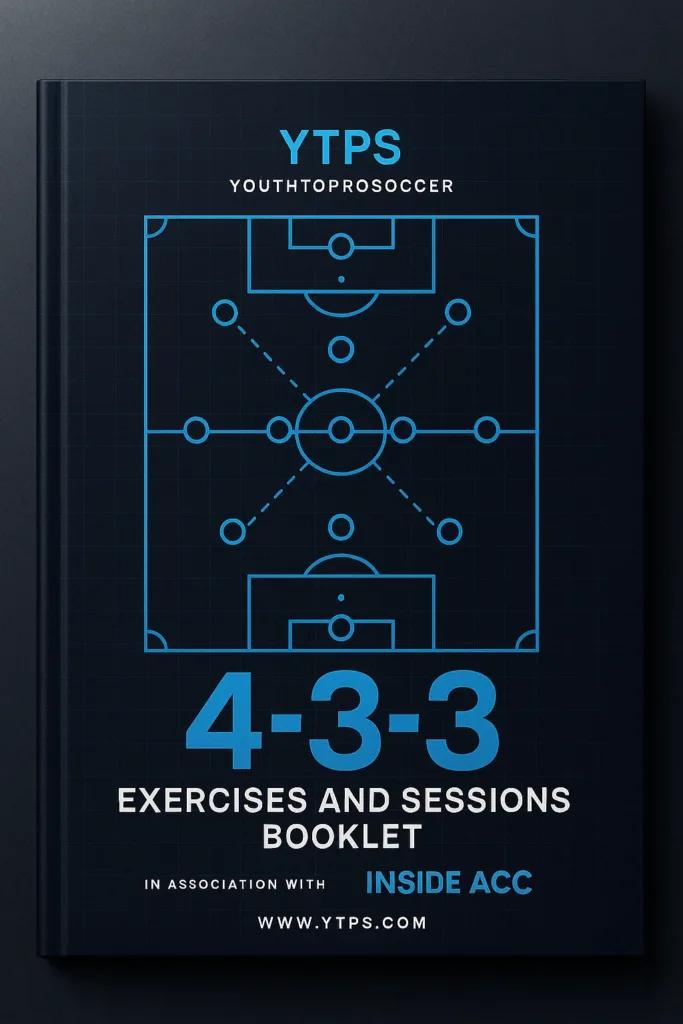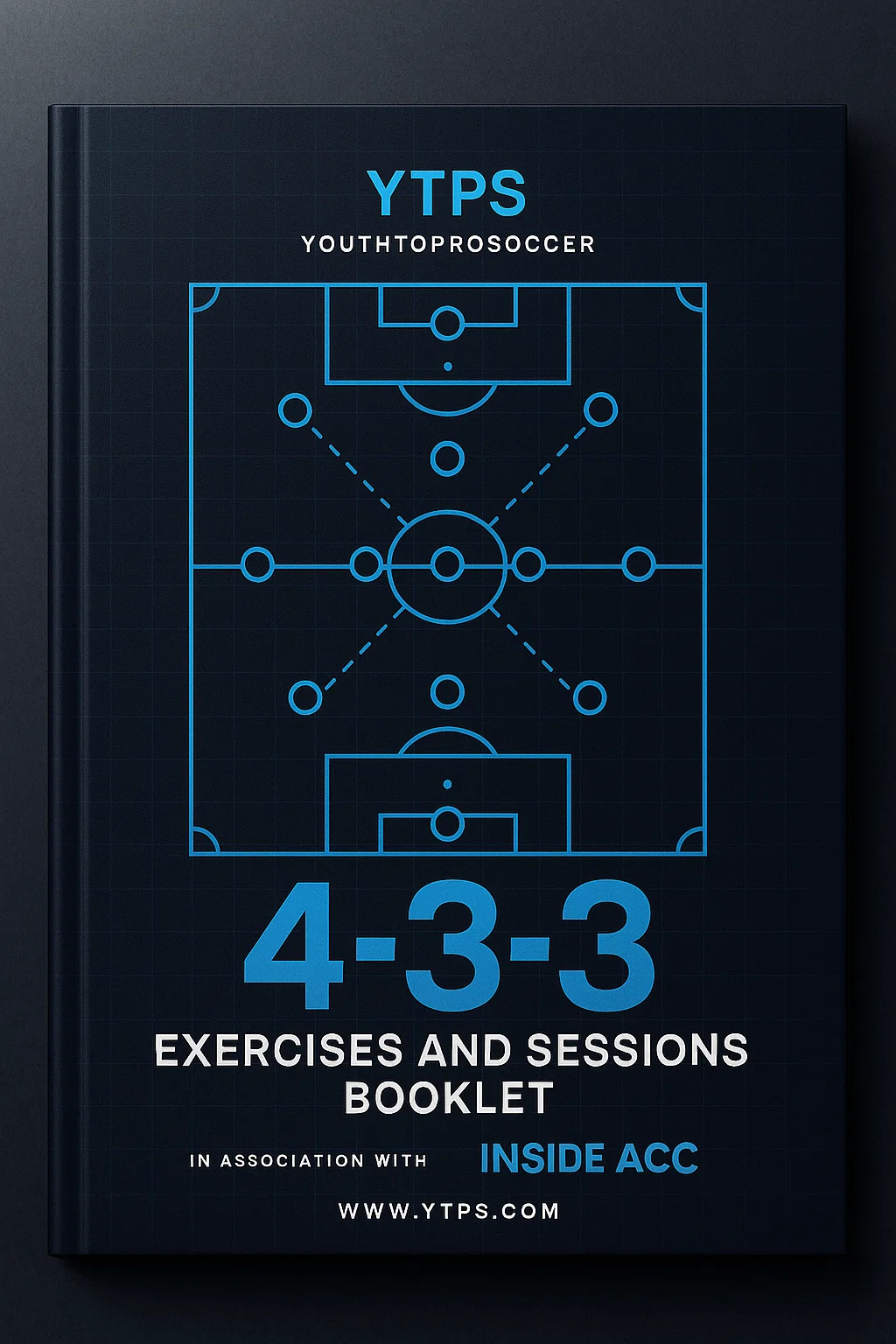
4-3-3 Exercises and Sessions Booklet
Introduction to the 4-3-3 Formation
The 4-3-3 formation has become one of the most influential and widely adopted tactical systems in modern football. It balances attacking creativity with defensive discipline and provides players with a flexible framework to adapt to different match situations. The “4-3-3 Exercises and Sessions Booklet” serves as a guide for coaches who want to teach their teams how to master this system.
This article explores the history, tactical framework, offensive and defensive principles, and practical training sessions from the booklet. Coaches will also find exercises designed to improve decision-making, teamwork, and positional awareness.
👉 For related resources, visit Pinbl Soccer Coaching.
Chapter 1: The Origins and Evolution of the 4-3-3
Football has always been a game of evolution. The early 2-3-5 pyramid dominated the 19th century, before Herbert Chapman introduced the WM formation in the 1920s. In the 1960s, Dutch coach Rinus Michels and the philosophy of Total Football gave birth to the modern 4-3-3.
- Ajax Amsterdam and later FC Barcelona showcased positional interchange and pressing.
- Johan Cruyff introduced it at Barcelona as both player and coach.
- In the modern era, Pep Guardiola and Jurgen Klopp redefined it with possession-based and pressing-based versions.
The 4-3-3 is no longer just a shape. It is a football identity.
👉 Learn more about tactical history in UEFA Coaching Resources.
Chapter 2: Why Coaches Prefer the 4-3-3
The reasons for its popularity are simple:
- Flexibility – It can shift into 4-2-3-1, 4-1-4-1, or 3-4-3 during transitions.
- Midfield Control – With three central players, coaches can dictate possession.
- Attacking Options – Wide forwards stretch defenses, while the striker creates central pressure.
- Defensive Solidity – The back four remains compact and disciplined.
👉 For youth training sessions, check Pinbl Youth Football Programs.
Chapter 3: Tactical Structure of the 4-3-3
1. The Defensive Line (4)
- Fullbacks support attacks but must recover quickly.
- Center-backs anchor the line, one often stepping up to intercept.
2. The Midfield Trio (3)
- Defensive Midfielder (No. 6): Shields the defense, breaks opposition play.
- Box-to-Box Midfielder (No. 8): Links defense to attack.
- Creative Midfielder (No. 10): Provides playmaking and assists.
3. The Forward Line (3)
- Right & Left Wingers: Stretch defenses, cut inside, or provide width.
- Central Striker: Target man, finisher, or false nine depending on style.
This structure offers positional balance and fluidity.
Chapter 4: Offensive Principles in the 4-3-3
The 4-3-3 is attack-minded by design. Offensive play focuses on:
- Building from the back – Goalkeepers and defenders initiate possession.
- Overloading the midfield – Triangles create numerical superiority.
- Exploiting wide areas – Wingers force fullbacks to make tough choices.
- Third-man runs – Midfielders arrive late into space.
- Finishing patterns – Striker supported by inverted wingers.
Coaches often use positional rondos and pattern-play exercises to refine these principles.
👉 Example: See this free guide on Rondo Soccer Training.
Chapter 5: Defensive Responsibilities
A good 4-3-3 is not only about attack — it requires intense collective defending.
- High Pressing: Front three cut passing lanes, forcing mistakes.
- Compact Midfield: Three midfielders protect central areas.
- Back Four Discipline: Center-backs remain tight, fullbacks recover fast.
- Transition Defense: Upon losing the ball, players counter-press immediately.
This creates a suffocating defensive block that frustrates opponents.
Chapter 6: Training Sessions and Drills
The “4-3-3 Exercises and Sessions Booklet” provides ready-made drills for coaches. Below are sample exercises:
1. Rondo Possession Drill (5v2 or 6v3)
- Develops quick passing and decision-making.
2. Wing Overload Drill
- 3 attackers vs 2 defenders in wide channels.
- Focus: creating chances through crosses or cutbacks.
3. Midfield Triangle Exercise
- Three midfielders rotate roles in possession.
- Improves awareness and fluid transitions.
4. Pressing Triggers Game
- Front three press when the ball enters fullback zones.
- Trains pressing coordination.
👉 For more free exercises, explore Pinbl Soccer Exercises.
Chapter 7: Player Development with the 4-3-3
The formation is ideal for youth development because it teaches:
- Positional discipline.
- Ball circulation and passing triangles.
- Teamwork and pressing.
- Creativity in attacking zones.
That’s why federations like US Soccer recommend it as the base structure for academies.
Chapter 8: Variations of the 4-3-3
Different coaches adapt the 4-3-3 to their philosophies:
- 4-3-3 Possession (Guardiola) – High ball retention.
- 4-3-3 Pressing (Klopp) – Relentless energy and transitions.
- 4-3-3 Counter (Mourinho) – Defensive block + fast counters.
- 4-3-3 Fluid (Luis Enrique) – Versatile roles, rotations.
Each version shows how flexible this system is in elite football.
Chapter 9: Common Challenges and Solutions
- Problem: Midfielders get overrun.
Solution: Drop one into a pivot (4-2-3-1). - Problem: Wingers isolated.
Solution: Fullbacks overlap to support. - Problem: Striker disconnected.
Solution: Use a false nine to link play.
Chapter 10: Advanced Coaching Tips
- Encourage triangular passing lanes at all times.
- Train positional rotations (fullback-midfielder-winger).
- Use video analysis to refine pressing structures.
- Incorporate small-sided games to simulate match scenarios.
👉 Coaches can explore advanced strategies on Coaches’ Voice.
Conclusion: Why the 4-3-3 Remains Timeless
The 4-3-3 formation is more than a system — it is a football philosophy. It empowers teams to dominate possession, control transitions, and press effectively. For youth academies, it serves as the perfect development tool. For elite clubs, it is the foundation of attacking football.
The “4-3-3 Exercises and Sessions Booklet” provides practical sessions to help coaches implement this formation successfully. By combining theory, training drills, and tactical awareness, coaches can create teams that play with intelligence, discipline, and creativity.
👉 For more tactical resources and free eBooks, visit Pinbl.xyz Coaching Materials.
👉 For global tactical insights, check FIFA Training Centre.

